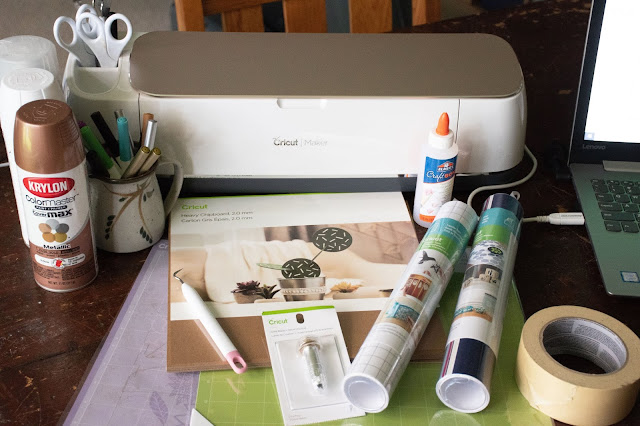*This post contains sponsored product and affiliate links. All opinions are authentic and my own. If you make a purchase after following an affiliate link, Woman in Real Life may earn a small commission. Your price is not affected.
I've been coveting the Cricut Maker™ cutting machine since it was launched a year ago. Yes I have the Cricut Explore Air and I love it (and will continue to love it). But Cricut Maker offers up more cutting options. It has a fast mode for up to 2x faster cutting and writing and an Adaptive Tool System™ for professional-level cutting performance.
The tools that work with Cricut Maker include a knife blade, which makes it possible to cut thicker materials (up to 2.4 mm) including chipboard. So, for my first project with my new Cricut Maker, I decided to go with a fun chipboard sign for my craft wall (which doesn't actually exist yet - this will act as a motivator).

Materials Needed For The "She's Crafty" Chipboard Banner:
- Cricut Maker
- knife blade
- StandardGrip mat
- StrongGrip mat
- chipboard
- vinyl in Midnight
- adhesive foil in stainless teal
- Cricut tools weeder
- transfer tape
- masking tape
- spray paint (I used white and rose gold)
- spray sealer (optional)
- paper craft glue
- glue gun
To Make The "She's Crafty" Chipboard Banner:
The chipboard banner comes from the "Well, Hello There" Design Space project. In that case the chipboard banner has different vinyl wording. Use that if you wish (it's really cute) or visit my project file to get the alternate wording. I figured "She's Crafty" is a good fit for my craft wall. Plus it reminds me of the Beastie Boys song. The fonts and images I used are free with Cricut Access. (I used Boys Will Be Boys block lettering, the Banner Com font and scissors from the available images.)
All of the instructions for this project are in the "Well, Hello There" Design Space file. Read my tips below for using the knife blade if you haven't used it before. As you can see in the photo above, one of the tips is to apply masking tape to the edge of your material when using a thicker material like chipboard. With the amount of pressure Maker applies, you don't want to take a chance your material might slip. Also, remember that the chipboard is not 12" x 12". That may seem obvious to others, but I actually moved some of the cuts too far to the right onscreen and had to cut one piece again on the second chipboard. (The project requires two sheets of chipboard and small amounts of vinyl and/or adhesive foil.)
Cut the wording and scissors image from adhesive foil and vinyl. I used adhesive foil in teal for the word "Crafty" because it's just the prettiest material. (You have to see it in real life!) I cut the word "She's" and the scissors from vinyl in Midnight.
Use transfer tape to transfer each word and the scissors to the chipboard banner, once complete. I was afraid the transfer tape might pull off some of the white spray paint, but it didn't. Just make sure the paint is fully dry. You really do need transfer tape, especially for the word "She's," because the font is so thin.
I chose to spray the back pieces of my chipboard banner with rose gold paint. I had used that particular can of spray paint before and it came out a little uneven this time (I guess the nozzle was a bit blocked), but most of the back panel ends up covered by the front pieces anyway.
I used paper craft glue to adhere the three back cuts of chipboard together (to form the back panel). I used a glue gun to adhere the front (white) pieces onto the back panel.
I have grand plans for a revitalized crafting area in the basement and my new sign is sure to be a part of it. I want to create storage for all the crafty things, including my Explore Air, the Maker and the EasyPress.
Included With Your New Cricut Maker:
(This is what came with my Cricut Maker from the Cricut online shop. If you purchase elsewhere, be sure to check the details to determine which items are included.)
- rotary blade and drive housing
- premium fine-point blade and housing
- fine-point pen
- FabricGrip Mat 12" x 12"
- LightGrip Mat 12" x 12"
- USB cable
- power cord
- materials for a first project
- Cricut Access trial membership
Additional Supplies You Might Want To Get:
Depending on the projects you plan to do withe Maker, you might want to get additional supplies. The Maker cuts fabric on the FabricGrip Mat without the need for a backer, so if you like to sew there are some additional goodies you'll want. Cricut even has pretty fabric samplers. Plus, you can access over 500 digital sewing patterns and quilt blocks from Simplicity® and Riley Blake™.
- knife blade
- scoring wheel (for razor-sharp creases in cardstock, poster board and more)
- sewing tool kit
- washable fabric pen for marking fabric pieces
- fabric
Tips For Using The Cricut Maker Knife Blade:
1. Calibrate your knife blade before doing any cutting. It's key to making accurate cuts. Design Space walks you through every step, or watch this Cricut video if you would like more help.
2. Use Design Space from your desktop or laptop computer, not from an iOS or Android device.
3. Use masking tape or blue painter's tape to secure material to StrongGrip mat on all four sides (and the corners if you feel it's necessary).
4. Move the white star wheels on the roller all the way to the right so they don't dent material.
5. The smallest pieces of your design and the interior of those pieces need to be greater than 3/4 of an inch. Any line needs to be larger than the diameter of a pencil. If they aren't they may not cut cleanly and you could break your blade.
6. Knife blade makes extra passes depending on your material. After it makes the first pass, Design Space will estimate how long the cut will take.
7, Add one more pass. When the mat is complete, you'll be prompted to check the cuts. If it hasn't cut all the way through, send it through again.
8. Project resume - if your machine stops cutting because of debris or a minor flaw in the material, see if the Cricut "C" button is flashing. Brush off debris and press the button to resume cutting.
9. Always use Design Space in a dedicated window. Avoid opening multiple tabs.
10. Turn off "Sleep" mode on your computer. You don't want your computer to time out while your project is cutting.
These tips come from this video from Cricut: 10 Things To Know About Knife Blade. Watch the video for a fuller explanation of these points.
Questions for you
Do you have the Cricut Maker? Do you have tips for using it? If you don't have Maker, is it on your wishlist? What kinds of projects are you hoping to make?
1. Calibrate your knife blade before doing any cutting. It's key to making accurate cuts. Design Space walks you through every step, or watch this Cricut video if you would like more help.
2. Use Design Space from your desktop or laptop computer, not from an iOS or Android device.
3. Use masking tape or blue painter's tape to secure material to StrongGrip mat on all four sides (and the corners if you feel it's necessary).
4. Move the white star wheels on the roller all the way to the right so they don't dent material.
5. The smallest pieces of your design and the interior of those pieces need to be greater than 3/4 of an inch. Any line needs to be larger than the diameter of a pencil. If they aren't they may not cut cleanly and you could break your blade.
6. Knife blade makes extra passes depending on your material. After it makes the first pass, Design Space will estimate how long the cut will take.
7, Add one more pass. When the mat is complete, you'll be prompted to check the cuts. If it hasn't cut all the way through, send it through again.
8. Project resume - if your machine stops cutting because of debris or a minor flaw in the material, see if the Cricut "C" button is flashing. Brush off debris and press the button to resume cutting.
9. Always use Design Space in a dedicated window. Avoid opening multiple tabs.
10. Turn off "Sleep" mode on your computer. You don't want your computer to time out while your project is cutting.
These tips come from this video from Cricut: 10 Things To Know About Knife Blade. Watch the video for a fuller explanation of these points.
2. Use Design Space from your desktop or laptop computer, not from an iOS or Android device.
3. Use masking tape or blue painter's tape to secure material to StrongGrip mat on all four sides (and the corners if you feel it's necessary).
4. Move the white star wheels on the roller all the way to the right so they don't dent material.
5. The smallest pieces of your design and the interior of those pieces need to be greater than 3/4 of an inch. Any line needs to be larger than the diameter of a pencil. If they aren't they may not cut cleanly and you could break your blade.
6. Knife blade makes extra passes depending on your material. After it makes the first pass, Design Space will estimate how long the cut will take.
7, Add one more pass. When the mat is complete, you'll be prompted to check the cuts. If it hasn't cut all the way through, send it through again.
8. Project resume - if your machine stops cutting because of debris or a minor flaw in the material, see if the Cricut "C" button is flashing. Brush off debris and press the button to resume cutting.
9. Always use Design Space in a dedicated window. Avoid opening multiple tabs.
10. Turn off "Sleep" mode on your computer. You don't want your computer to time out while your project is cutting.
These tips come from this video from Cricut: 10 Things To Know About Knife Blade. Watch the video for a fuller explanation of these points.
Questions for you
Do you have the Cricut Maker? Do you have tips for using it? If you don't have Maker, is it on your wishlist? What kinds of projects are you hoping to make?















This looks great, I would love love love to have a cricut!
ReplyDeleteThank you! Yes, all of the Cricut machines are loads of fun. :)
Deletea close friend recently got one! I'm definitely curious to check it out!
ReplyDeleteOh that's great! Would be fun to try it through a friend first to see if you like it.
Delete